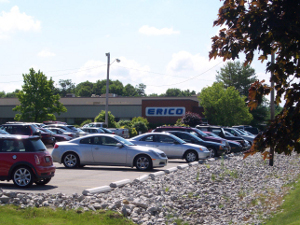 ERICO Headquarters, Solon, Ohio
ERICO Headquarters, Solon, Ohio
We keep being surprised and delighted by the benefits we accrue through studying family history as we travel. Today we learned more of how grandfather Charles Cadwell's invention, called the Cadwell Bond, or CADWELD (registered trademark), played a significant part in building an international company which today has 1300 employees in 24 countries.
 ERICO Headquarters, Solon, Ohio
ERICO Headquarters, Solon, Ohio
ERICO, which was once called the Electric Railway Improvement Company, has its headquarters in Solon, Ohio, southeast of Cleveland. The company was formed around 1901 by a bunch of engineers from The Case School of Applied Science in Cleveland (now merged into Case Western Reserve University), and has always been privately held and managed by Case alumni. Charles Cadwell graduated from Case in 1895 and became an instructor the following year. Like most engineers of the time, Charles was a jack of all trades - mathematics, geology, chemistry, mining, metallurgy and civil engineering.
Electric railways became very popular about this time; they were relatively quiet and less expensive to build and operate than steam powered systems, but they had one serious drawback; the railbeds were quickly laid over surface routes, so the electric connections were constantly breaking as the rails expanded and contracted. Repairing these connections required wagons to travel along the rails, interrupting commercial service. Furthermore, faulty ground connections led to electrical accidents. What was needed was a reliable and permanent way of bonding the large electrical cables to each other, to the rails, and to ground. Even railways which relied on steam locomotives required reliable electrical connections to operate railway signals. ERICO's business started around providing engineering services to these railroads.
After Charles Cadwell left the Case faculty he worked as a consulting engineer, and in 1921 was working for the Long Island Rail Road at their Morris Park Shops in the Bronx. Here's what happened, according to the ERICO company history: "He was installing signal bonds at that time by melting copper in a kerosene furnace and pouring same into a mold attached to the rail and into which the signal cable had been placed. In taking shelter in a warehouse during a storm he noted a heavy barrel of copper oxide which had accumulated from discarded battery cells. Having in mind an exothermic reaction for producing the hot metal for a bonding operation, Mr. Cadwell secured a keg of this copper oxide and had it shipped to Cleveland for experimental purposes. ... These experiments ran along until 1930 when Mr. Cadwell made up a cartridge using a copper-aluminum alloy... "
 Freshly made Cadwell Bond
Freshly made Cadwell Bond
As we observed demonstrations of the CADWELD process, we realized why nine years of R&D were needed to perfect the technique. The intense heat of the reacting material could easily melt the copper cable which is being bonded and so weaken the connection. On the other hand, at the precise center of the welded joint the copper should melt and become part of the copper - aluminum alloy which forms the ultimate bond. The carefully engineered graphite block which serves both as an enclosure for the exothermic reaction and as a mold for the casting also conducts the heat properly to control the process. At the same time, the CADWELD procedure had to be simple and reliable enough to be performed in the field by workmen without extensive specialized training.
Once perfected, CADWELD got the job done in the twinkling of an eye, and became an immediate commercial success. It provided the bulk of ERICO's revenue through the 1930s, and continues to be a significant product line for ERICO up to the present. In fact Erico has just introduced CADWELD 2, which is a self-contained prepackaged charge and igniter, which is faster to apply and simpler to manufacture.
Our visit was set up and coordinated by Andy Weisel, vice president in charge of sales for the Facility Electrical Protection Division of ERICO. Lynn DeLisle, the plant manager gave us a plant tour, while George Kub demonstrated the old and new ways of creating a CADWELD. Later we shared a few Cadwell stories and promised to stay in touch. We left well-equipped with ERICO pens, umbrellas and a duffel bag, plus a goodly supply of company literature. Soon we hope to have a copy of the company history to study at our leisure. For our part, we're continuing to seek memorabilia of Charles Cadwell to share with ERICO.
Charles Cadwell was known to his family as a quiet man with a nice sense of humor who said little about his professional life. While other relatives have made more money, Charles' invention lives on long after his death in 1947, and we were especially moved to listen to some employees who have enjoyed good careers for thirty or more years making Cadwell bonds. ERICO pays out sizeable bonuses (close to 25% of annual income) each fall, and the employees all seemed loyal and dedicated.
All we could say as we drove back to our hotel was "Wow!"